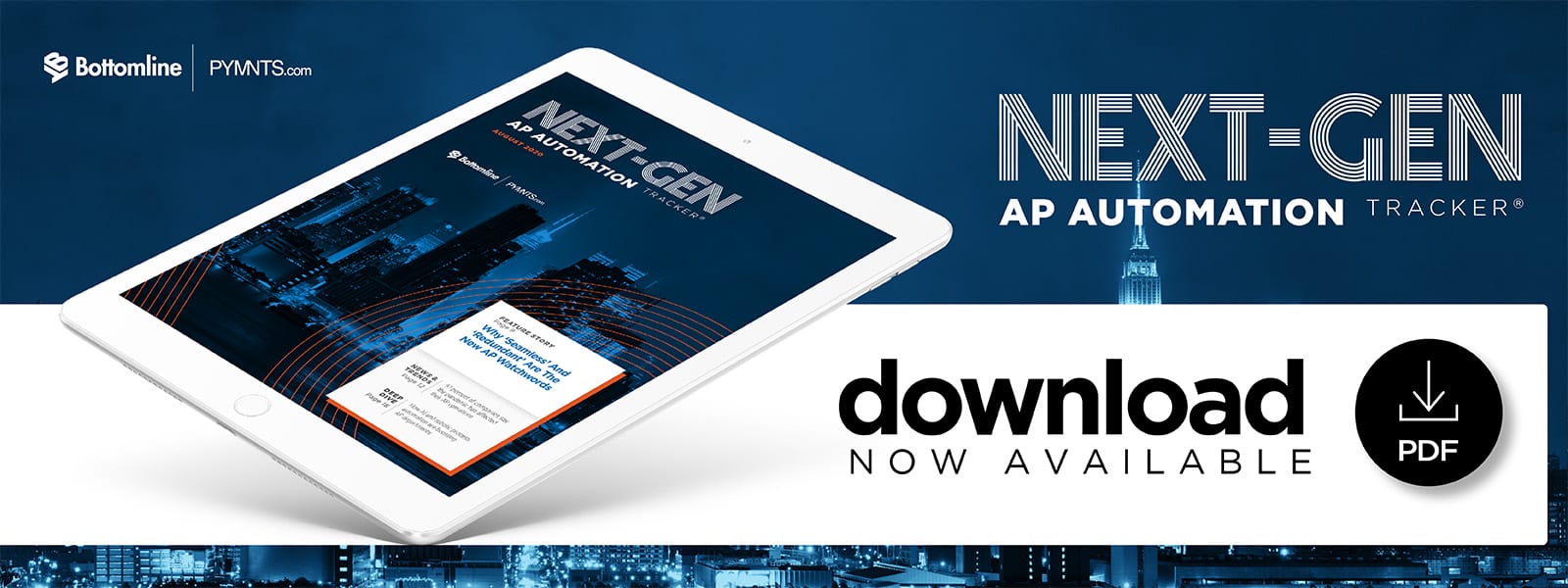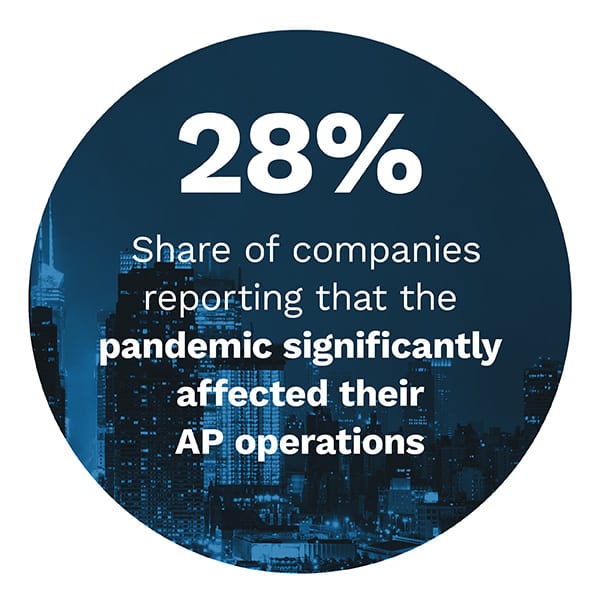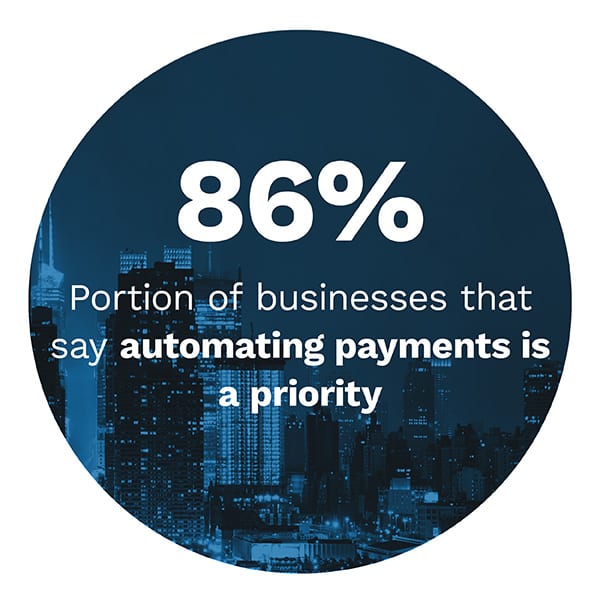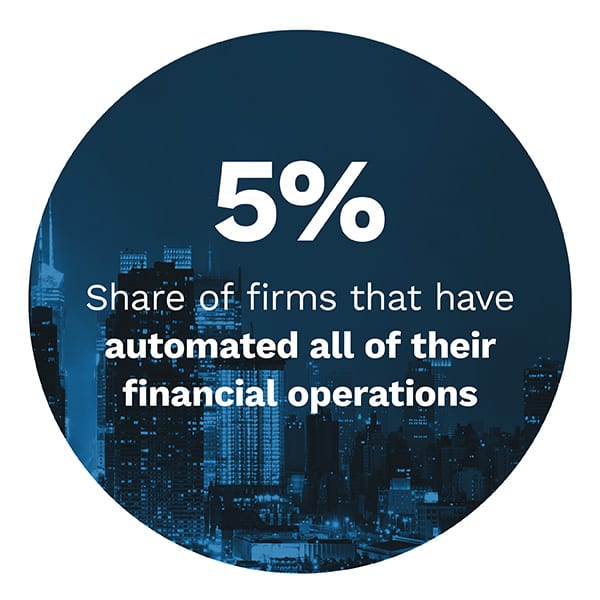TD Bank: Making AP Departments Digital And Resilient

 Businesses are not anticipating a smooth return to normalcy, with 43.5 percent of treasurers saying in a global poll that they expect the economic recovery to follow a “W”-shape, rather than the much-hoped-for “V”-shape. Organizations that are adjusting their processes to meet the conditions imposed by the pandemic therefore may need to make these changes for the long-term, without expecting to be able to quickly resume old methods.
Businesses are not anticipating a smooth return to normalcy, with 43.5 percent of treasurers saying in a global poll that they expect the economic recovery to follow a “W”-shape, rather than the much-hoped-for “V”-shape. Organizations that are adjusting their processes to meet the conditions imposed by the pandemic therefore may need to make these changes for the long-term, without expecting to be able to quickly resume old methods.
This has serious implications for businesses that had relied on manual, paper-based accounts payable (AP) practices before doing so became both challenging and potentially unsafe. Financial departments that have held off on updating their AP processes may now feel a stronger call to adopt technologies that will support smooth, remote AP operations well  into the future.
into the future.
The August Next-Gen AP Automation Tracker® examines how financial teams have been revising all aspects of their AP departments, including how they receive invoices and make vendor payments.
Around The AP Automation World
The COVID-19 pandemic made the prospect of requiring staff to go on-site and physically sign off on payments a public health risk. However, corporate buyers still want to have strong oversight and control over their high-value payments. The need for secure authorization and employee safety has led some companies to now adopt electronic signature solutions that enable staff to sign payments approvals remotely.
AP departments are also working to better catch mistakes that could prompt them to overpay during a time when budgets are already strained. Human errors can slip in when financial staff manually enter invoices into payment systems or vendors may make mistakes when writing those bills, resulting in issues like incorrect charges and duplicate invoices. Some AP teams, therefore, are implementing digital solutions that can help detect such problems before payme nts are sent.
nts are sent.
The push to greater digitization of payments processes is sometimes conducted on a government-wide scale. Estonia recently hit the one-year anniversary of when its public agencies stopped accepting paper invoices. This public sector policy appears to have also prompted greater private sector use of digital invoices as well, according to recent accounts.
Find more about these and all the latest AP automation headlines in the Tracker.
The AP Practices Emerging From The Pandemic
Companies have adopted new AP strategies as the pandemic disrupts long-held approaches, but the changes being made are not quick patches to be abandoned once the pandemic recedes. Neil McHugh, head of commercial operating products in corporate products and services at TD Bank, explained in this month’s Feature Story how many companies are adopting AP approaches that will become regarded as the new “best practices.” This refreshed form of AP includes digitized payment flows that bring greater efficiency and built-in AP redundancies that protect operations against the potential of future disruptions.
Find the full story in the Tracker.
Deep Dive: How AI And Robotic Process Automation Could Le ad The Way To Better AP
ad The Way To Better AP
Invoices may arrive formatted in idiosyncratic ways or displaying difficult to decipher handwriting, and financial teams then have to spend valuable time contacting vendors to clarify details. That slows down what can already be time-consuming manual invoice processing procedures. Automation tools can eliminate much of these frictions, however. This month’s Deep Dive examines how robotic process automation (RPA) tools paired with artificial intelligence (AI)-powered optical character recognition (OCR) technologies can save employees time and improve accuracy by reviewing and reformatting invoices as well as verifying and correcting details.
Download the Tracker to read more.
About The Tracker
The Next-Gen AP Automation Tracker®, a PYMNTS and Bottomline Technologies collaboration, is a monthly report that highlights the most recent accounts payable developments and automated solutions disrupting how businesses process invoices, track spending and earn rebates on transactions.
March Madness 2025 and Beyond: When AI Meets the Big Dance

As the calendar flips to March, college basketball fans are gearing up for another exhilarating NCAA tournament.
In the future, artificial intelligence and cutting-edge technology could change March Madness as we know it. Let’s break down how the digital revolution could transform the Big Dance.
AI Bracketology: The New Sixth Man
AI is already being used to predict brackets. Gone are the days of agonizing over your picks based on team mascots or your alma mater’s colors. In 2025, AI-powered bracketology is the name of the game. Fans can use algorithms that crunch data points, from player statistics to historical upset probabilities, all at the click of a button.
But beware, bracket enthusiasts. While these AI tools promise to boost your chances of winning the office pool, they can’t account for the quintessential March Madness chaos. You know, the instance where AI can predict everything except the inevitable Cinderella story that ruins everyone’s bracket by the second round.
The Rise of the Robo-Commentators
In a move that would be sure to ruffle some feathers, AI-generated commentary could be used for games. Digital play-by-play announcers would never need a bathroom break and potentially be able to recall obscure statistics from the 1957 tournament in an instant.
Virtual Reality Courtside Seats
Can’t make it to the Final Four? Ten years from now, games might happen in a digital stadium, Forbes reported. With virtual reality (VR) technology, fans could experience the thrill of courtside seats from the comfort of their living rooms.
“AI-generated athletes, inspired by the procedural generation techniques of video game developers … could perform in virtual arenas, exhibiting strategies and plays conceived by advanced predictive algorithms,” Forbes reported.
Just be careful not to get too caught up in the moment with streaming. Wouldn’t want to have reports of fans attempting to rush the virtual court after buzzer-beaters have led to an uptick in living room injuries — especially when that flat screen falls over.
AI Coaches: The Ultimate Clipboard Holder
While human coaches still call the shots, AI assistants could one day be indispensable members of the coaching staff. In the next five years, these digital strategists could analyze opponent tendencies and more.
“Building on existing technologies … AI will provide coaches and players with intricate, multi-dimensional data patterns that dramatically enhance both offensive and defensive strategies,” Forbes reported. “These advanced algorithms will analyze vast datasets from numerous games to uncover hidden trends, strategic insights, and predictive cues about opponents’ potential moves.”
The Referee’s New Best Friend: Computer Vision
Say goodbye to controversial calls. Advanced computer vision systems could assist referees in making split-second decisions, from determining if a player’s toe was on the line for a three-pointer to detecting the slightest touch on a blocked shot.
The Hawk-Eye system is already used in tennis and cricket to help determine fouls, Viso.AI reported.
“This system uses a network of cameras to track the ball and then compares the trajectory of the ball to a virtual model of the playing surface,” the report said. “This system is accurate within a few millimeters, which is much more accurate than the human eye.”
The Future of Fandom
As we dive into March Madness 2025, it’s clear that technology will change the way we experience the tournament. From AI-powered brackets to virtual reality arenas, the digital revolution is coming for basketball. But at its core, the magic of March Madness remains the thrill of competition, the joy of unexpected victories, and the heartbreak of last-second defeats.
So, whether you’re relying on an AI to pick your bracket this year, or screaming at a holographic referee in the future, remember to enjoy the ride. In the unpredictable world of college basketball, sometimes the best strategy is to embrace the madness — digital or otherwise.
For all PYMNTS AI coverage, subscribe to the daily AI Newsletter.